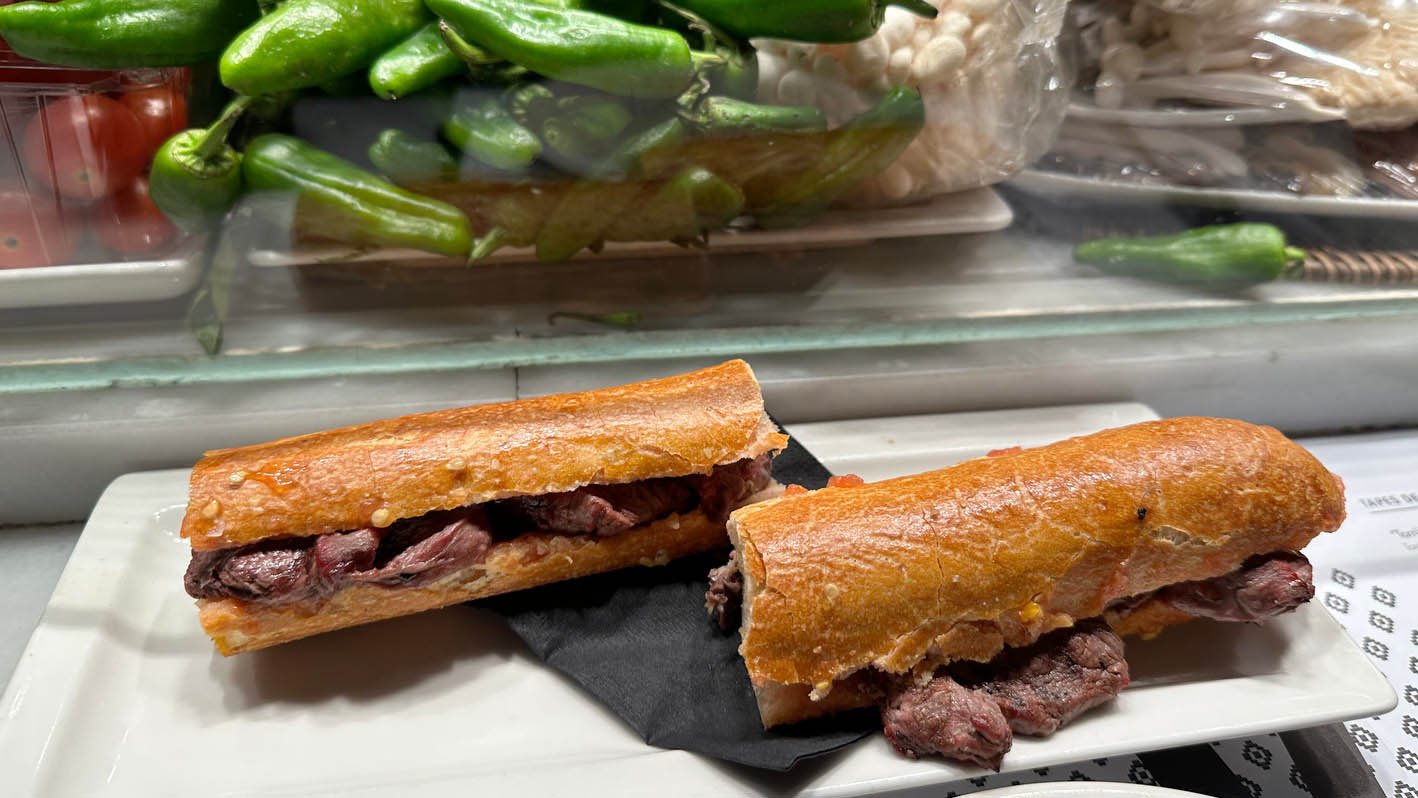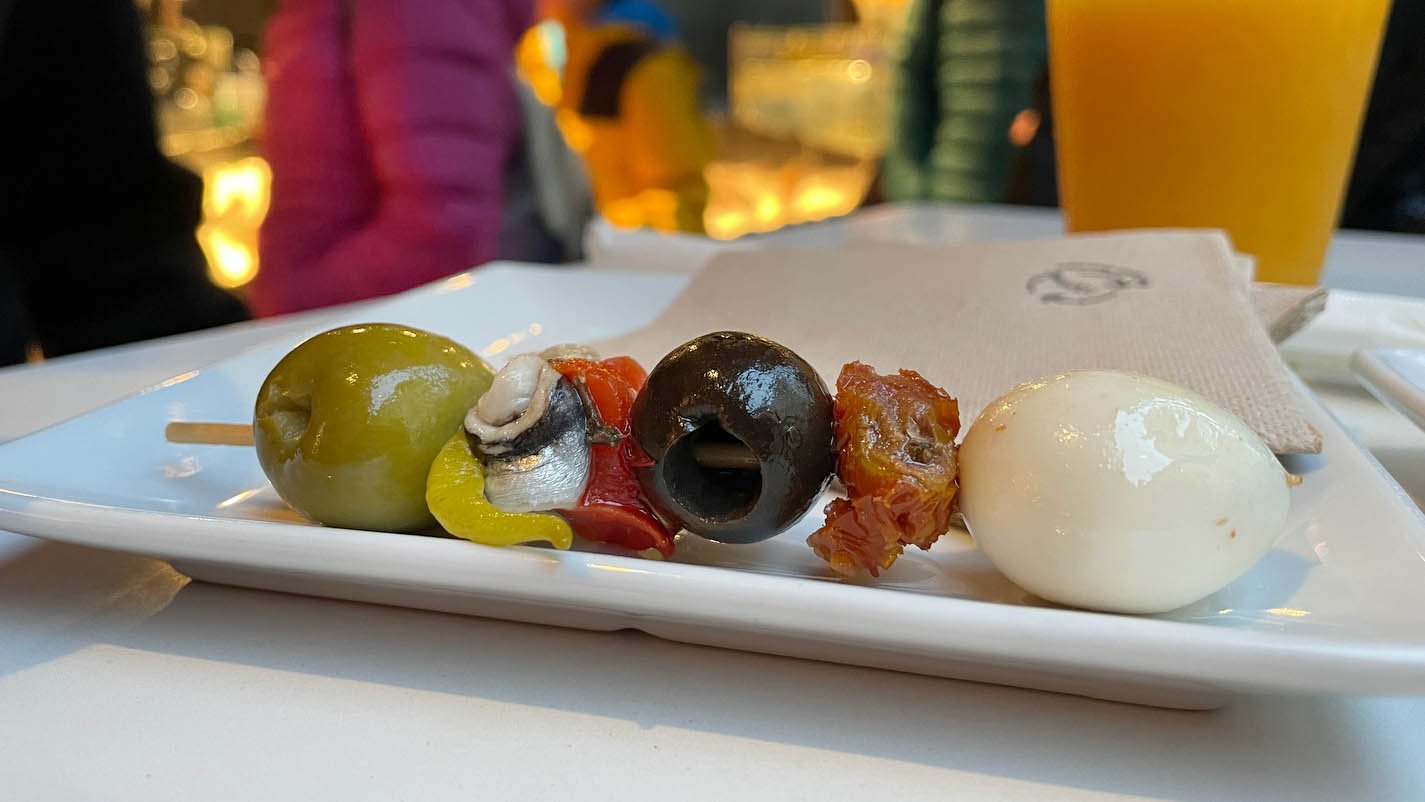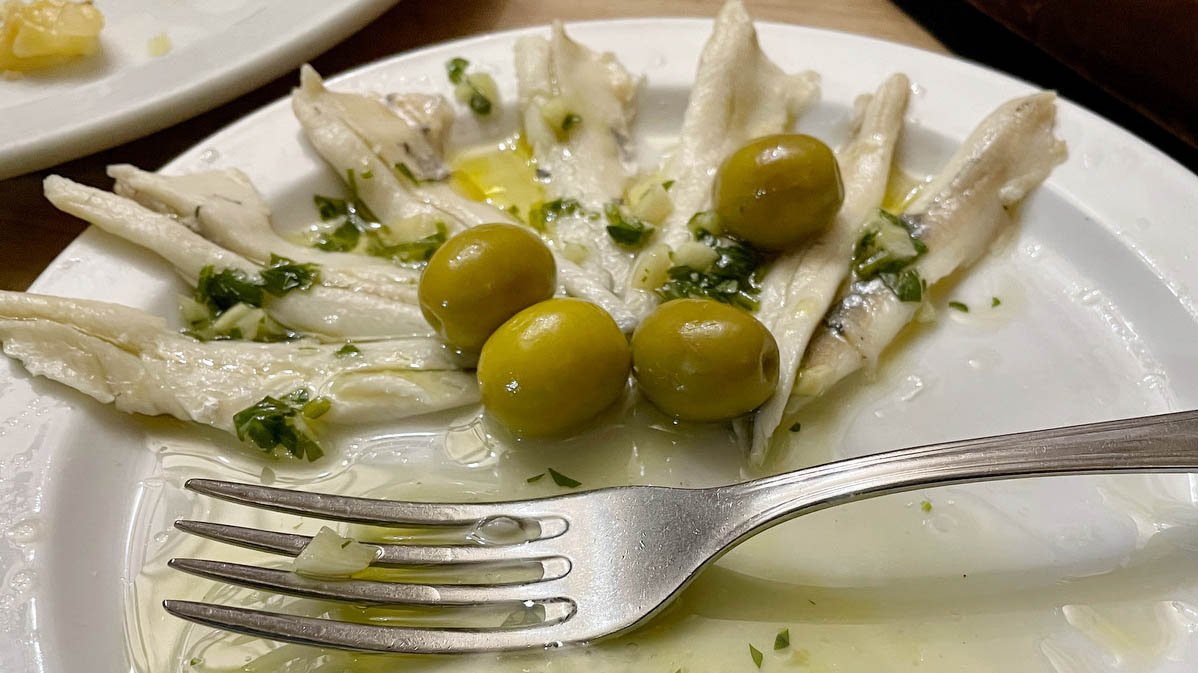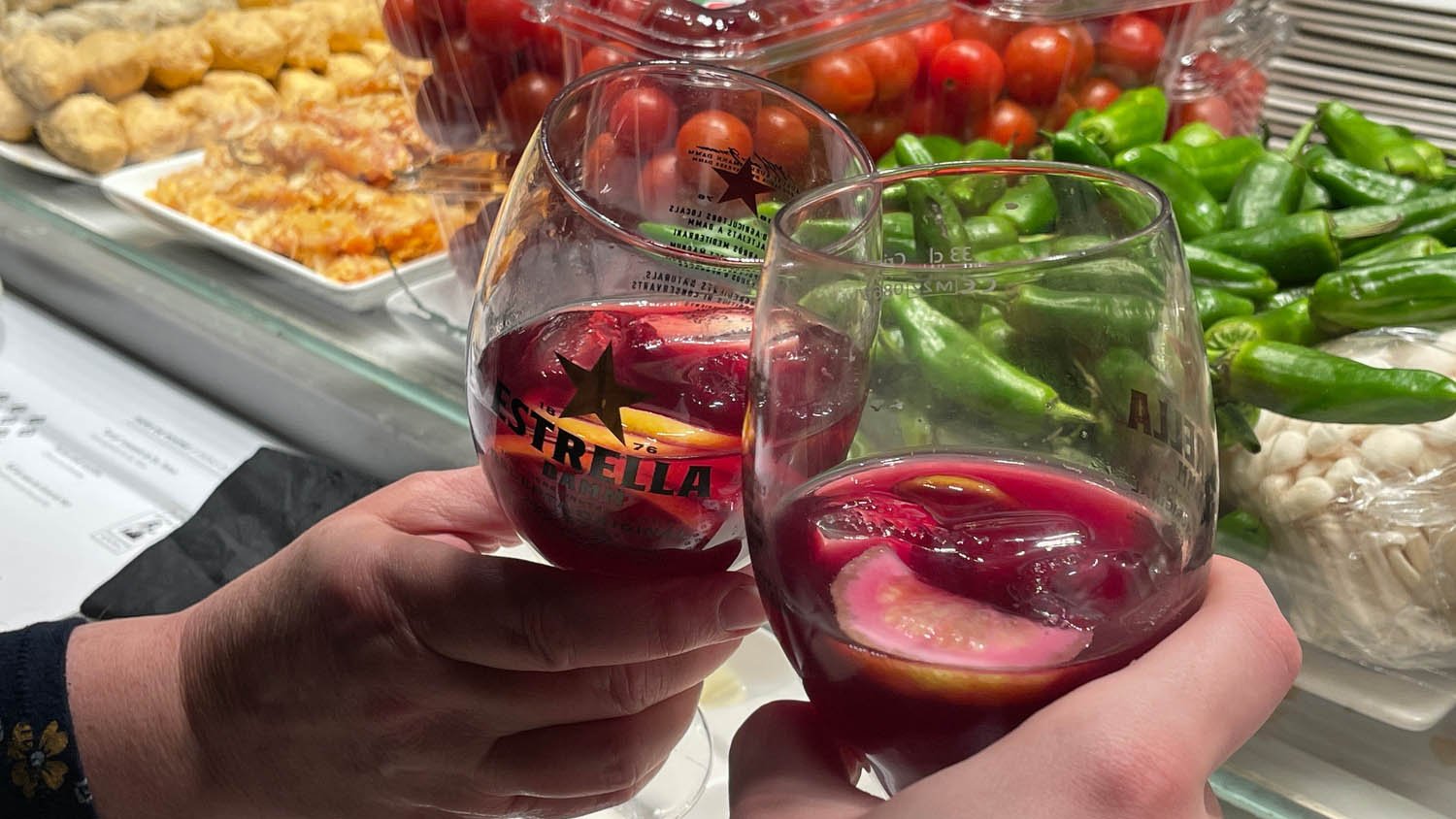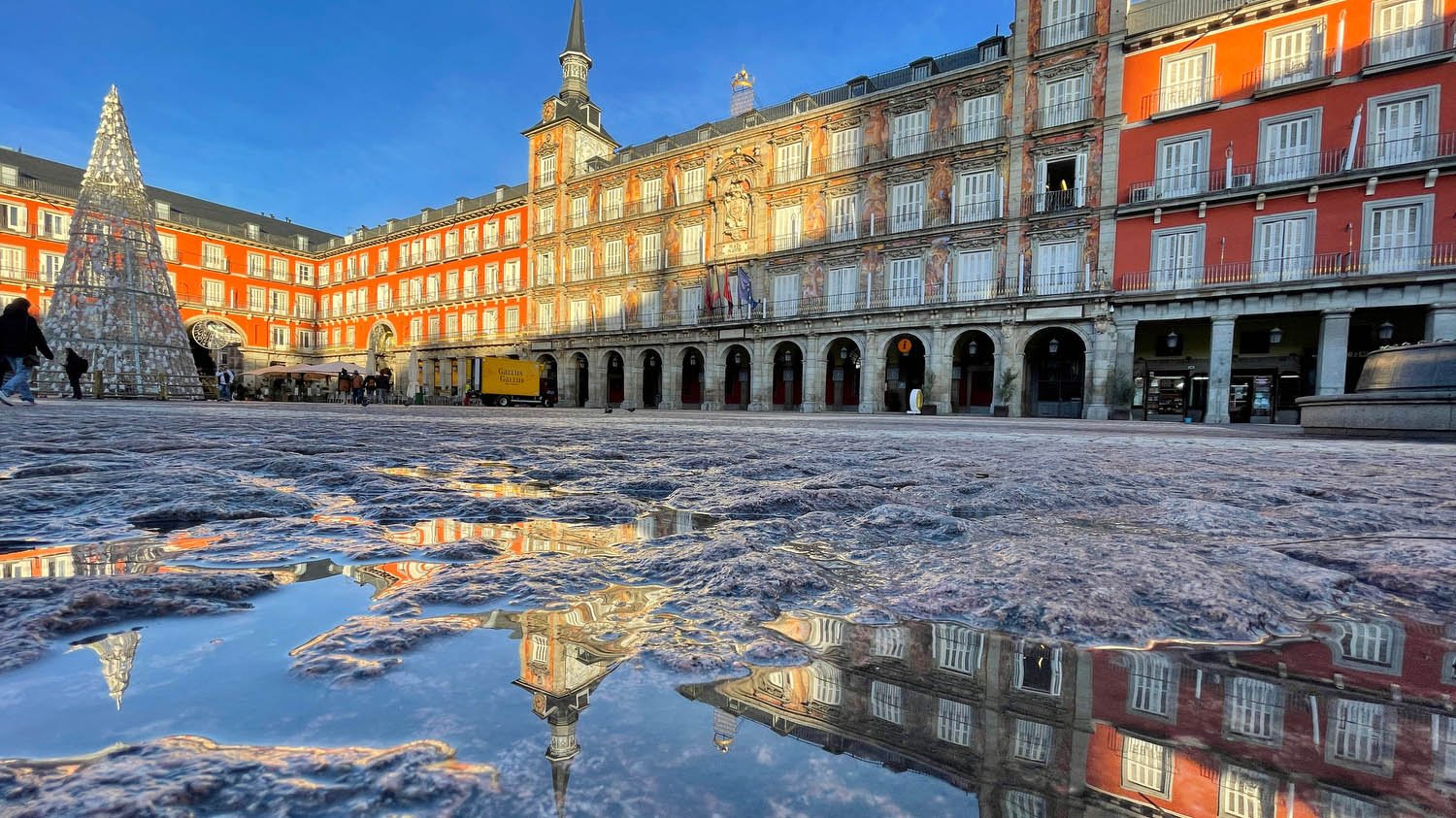What to eat in Spain
Let’s talk FOOD while visiting Spain! Mouthwatering ham reigns supreme, but also expect to sample superb seafood, deliciously subtle olive oil, distinct cheeses, and beautiful fresh vegetables. And don’t forget the chocolate and fried churros!
It’s not an overstatement to say that we truly fell in love with the food of Spain, almost to our surprise. The laid-back tapas culture and many markets for grazing suited our culinary style just right.
We may even go so far as to say that Spain wins as our favorite country for food (so far, anyway!).
There are so many delicious things you simply must try while visiting Spain, and we’ve put together a list of our favorites for you.
Patas Bravas Photo by John O’Boyle.
Foods you must try in Spain:
Pan Con Tomate (Spanish Tomato Bread)
Patatas Bravas
Jamón Iberico and Jamón Serrano
Chorizo
Manchego cheese and other artisan cheeses
Bocadillo
Anchovies boquerones
Gambas al ajillo (prawns in garlic oil)
Paella
Croqueta (Spanish croquettes)
Empanadas
Pimentos de padron
Tortilla Española
Churros con chocolate
Bonus! - drinks to try in Spain
Sangria
Tinto de Verano
Beer in a little glass
Pan Con Tomate (Spanish Tomato Bread)
We encountered this popular tapas food literally everywhere we went in Spain, from hotel breakfast buffets, to bars, to fine restaurants. Though typically considered to be a Catalan bar food in origin, it really is everywhere.
Pan Con Tomate. Photo by John O’Boyle
Pan con tomate literally translates to "bread with tomato", and that’s pretty much the recipe. It is made with a few simple ingredients: fresh, very ripe tomatoes with garlic, good extra virgin olive oil, and a dash of salt.
It is similar to Italian style bruschetta; but whereas bruschetta is made from diced tomatoes, mixed with herbs, and served on top of crostini, pan de tomate is even simpler than that. It is made by rubbing fresh garlic and ripe tomatoes directly over warmed rustic bread, or by grating the tomato into a skinless puree and spreading it over oiled and garlicked crusty bread.
The simplest of foods, it’s usually everyone’s first tapa; and what a great introduction it is!
Patatas Bravas
Next on the hit parade of well loved dishes in Spain is Patatas Bravas. At its most basic level, Patatas Bravas is fried chunks of potato drizzled with a slightly spicy, smokey, paprika-y red sauce. It is one of the most popular items on tapas menus.
The fun thing about Patatas Bravas is everyone does it a little differently - the recipe changes regionally and even from eatery to eatery. It can sometimes be served with a white garlic aioli on top or in place of the traditional bravas sauce - or “salsa brava”. The presentation can be rustic or fancy. But the uniting factor is always those lovely fried potatoes.
We loved ordering this dish everywhere we went to try all the different spins on it.
And let’s face it - “Patatas Bravas” is just fun to say!
Another version of Patas Bravas. Photo by Debbie O’Boyle
Jamón Iberico and Jamón Serrano
Spain really does love their ham - in fact, if “jamón” is the first word you learn in Spanish, you can walk into any tapas bar and have yourself a party. (and I’m only exaggerating a little!) The Pig is King.
Spain has a longstanding tradition of curing ham and other meats that dates back to Roman times, and today produces more dry cured ham than anywhere in the world. You can find it everywhere and it is buttery, savory and delicious.
A variety of ham on display in a Madrid store. Photo by John O’Boyle
Giant legs of jamón serrano and jamón ibérico hang in shops and bars, and slicing the cured ham into thin strips is a learned art, utilizing century-old techniques. Jamón Iberico or Iberian ham is made from black Iberian pigs; while ham labeled as Serrano comes from several specific breeds of white pigs. The term “serrano” means “from the mountains”, referring to a time long ago when the meat was salted and cured for a number of days in mountain air.
Both are rich in flavor and very delectable, though I do have a preference for Serrano, I think. I might even like it better than Italian prosciutto - which is a VERY high bar to cross for my palate. Serrano is less fatty than prosciutto, darker in color, heartier in texture and a little stronger in flavor. You will find both Iberico and Serrano hams served on platters and charcuterie boards, paired with fine Spanish cheeses, bread & olives, and sometimes with Pan Con Tomate. But the best way to enjoy it is on its own!
The ham photo above was taken during a tapas tour in Madrid. You can read about our tapas tour, eating our way through San Miguel Market and sample delicious chocolate & churros at the famous San Gines in our post: Visiting Madrid: 8 great things to do
Chorizo
Speaking of superb Spanish pork products, let’s not overlook the obvious! The smoky, spicy sausage Chorizo is well-known in the US, but do make sure you sample the real deal while in Spain. It’s better than you can imagine. You can order it as a tapa or small plate in most bars and it is often used as an ingredient and flavor enhancer in many dishes.
A platter including ham, chorizo and Manchego cheese. Photo by John O’Boyle
Manchego Cheese & other artisan cheeses
There is much to love about Spanish cheeses. They can be sweet or piquant, depending on the region they come from, how long they are aged and what kind of milk is used to make them. In general, cow’s milk cheeses come from the north, while goat’s milk cheese predominates in the south and central regions, and in the east it’s all about the sheep’s milk.
We are FareDrop customers and love it, they send airfare sales for your home airport right to your inbox. It’s great!
Note - This blog post contains affiliate links. This means that if we are recommending a product, activity, or hotel, we might be receiving a small commission if you buy or book from these links. This is done at no additional cost to you. We only recommend products we have personally used or have thoroughly researched.
Manchego cheese is perhaps the most well-known cheese of Spain, and is made from sheep’s milk of the La Mancha region (home to Don Quixote). This mild, slightly salty cheese is found pretty much everywhere, served up on platters with tasty sliced jamón and a sweet quince paste called membrillo, which is kind of a sliceable jelly. Manchego is hands-down Spain’s most popular cheese and for good reason - it’s delicious and easy to love.
Cabrales cheese is a punchy blue cheese that can be made of cow’s milk alone or mixed with goat’s or sheep’s milk. Spanish blue cheese comes in different levels of sharpness, with cabrales suave - or “gentle cabrales” - being a particularly delicious soft option that is often spread on warm bread or used in baked dishes. Worth a try even if you don’t usually care for the taste of blue cheeses.
Idiazabal cheese, from the Basque Country and Navarre, is made from raw sheep’s milk and is aged for at least two months - in caves!. It’s a hard cheese that is sometimes smoked, giving it a brownish color. If unsmoked it is more of a light beige. It has a relatively strong, sharp flavor. Great with that membrillo!
Mahón cheese is a smooth, soft white cheese produced from cow’s milk of the Balearic Islands. It’s a sweet, fruity cheese with a slight kick of saltiness, since the cows graze on grass that has traces of sea salt. It can be loosely compared to gouda, but has a unique flavor profile of its own, which can vary in pungency with how much it is aged. Younger cheeses are softer and milder. You can recognize mahón on your charcuterie platter by its orange-tinged rind, which is created when the rind is rubbed with oil and paprika.
If shopping in a local supermarket (which is always fun when visiting a new country, so I highly recommend it) look for queso con romero, which translates to “cheese with rosemary”. This is a sheep’s milk cheese that is wrapped in rosemary as it ages, imparting a nutty and floral flavor. This is a local favorite, found in most markets and worth picking up some to snack on in your room.
Can we talk about how much I loved those little crunchy crackers that came with every cheese board in Spain?! They are called Picos, and resemble little loaves of bread. I tried very hard to find them when I got home in every international market but haven’t had any success. :( If you know where to get them in the US, please hit us up with an email at hello@theemptynestexploreres.com and let us know!
Our favorite crackers - Picos, with a variety of cheese and vegetables. Photo by Debbie O’Boyle
Bocadillo
The bocadillo is a traditional Spanish sandwich made with a Spanish flauta bread - “flauta” means “flute” and is similar to a baguette or other long crispy bread. The flauta is cut lengthwise and filled with almost anything - jamón Iberico, other meats, cheeses, seafood, tomato, even egg & potato. Fillings can be somewhat regional, and tapas bars and cafes often pride themselves in their own unique specialities. Considered a low cost and humble food, the bocadillo has evolved over time from a beloved street food into an iconic part of Spanish cuisine.
Some bocadillos are seasoned with sauces like mayonnaise, aioli, mustard or tomato sauce. They are usually enjoyed with cold beer, red wine or coffee. We had a beef bocadillo to die for at Vinitus in Barcelona. :)
Bocadillo at Vintus in Barcelona. Photo by John O’Boyle
Boquerones (Anchovies) & other seafood
If the only anchovies you are familiar with are those shriveled, salty, nasty bits that nobody wants on their pizza, you need to open your mind to Spanish boquerones.
In Spain, anchovies are eaten both fresh and cured. The cured kind - the ones you find in jars and cans - are called anchoas. The fresh (uncured and unsalted) anchovies are known as boquerones, and these are the ones you must try!
Boquerones are often simply fried in olive oil and served as tapas. They are tender, white and juicy, and have a mild, delicate flavor. They do not have a fishy or briney taste, as they are not preserved in salt.
I loved sampling them at Mercado de San Miguel in Madrid on a little skewer with a quail egg, peppers and an olive! Yum! They are also a staple of tapas bars.
Spain is a perfect place to expand your seafood horizons in general. Spain is surrounded by sea and is blessed with both warm water swimmy things from the Mediterranean and cold water varieties from the North Atlantic, so there are plenty of fresh choices. Preparation is almost always simple - fried, boiled, or grilled, seasoned with salt and olive oil, or stewed into paella. No, you won’t find any tartar sauce here. The quality of the ingredients is all the taste enhancement you need.
So go ahead and try some octopus - or “pilpo” - which is so popular, there are restaurants that specialize in this one seafood, called “pulperias.” Or maybe you’d enjoy some langostinos, clams, prawns & shrimps, crabs, lobster, mussels - well you get the idea. The point I’m making is - you may be pleasantly surprised how good it all is.
Gambas al ajillo (prawns in garlic oil)
Although we already talked about seafood generally, gambas al ajillo deserves its own mention. A simple yet hearty staple of the Iberian peninsula, this sizzling dish of prawns and olive oil, seasoned with garlic, green chili, and parsley, is the epitome of comfort food; warm, tasty and satisfying. You can also get it with added chorizo for an extra kick.
Usually served in a stoneware crock, it begs you to swipe some bread into that delicious seasoned oil once the prawns are all gone! Yum!
Sharing mussels, croquetas and patas bravas. Photo by John O’Boyle
Paella
Paella is probably the dish most associated with Spain and has worldwide popularity - expect everyone to ask you if you had paella when you return home! It was the Moors who first brought rice to Spain, where it was embraced with enthusiasm.
Traditional paella is a rice dish born of Valencia. It gets its name from the Valencian word for “frying pan”, as it is cooked in a wide, round, shallow pan with short handles on either side. This style of pan allows for even water evaporation that gives the rice a perfect texture and a crispy crust at the bottom that is an essential part of the dish. It is served directly to table in the pan and like many traditional Spanish foods, it is meant to be shared in good company,
The rice is always seasoned with saffron, giving it a golden hue and an earthy, sweet flavor. It also gets depth of flavor from an aromatic sofrito of onions, peppers, tomatoes and garlic, and additional seasonings of paprika, rosemary, and cayenne pepper.
Adorning the rice is a combination of meats, fresh seafood and vegetables. Chicken, chorizo, rabbit, shrimp, shellfish, eel, pork, peas or beans may be part of the recipe, creating a one-dish meal that requires no side dishes at all.
Locals will definitively tell you that the best place to have paella is in Valencia, where it comes from. But it is possible to find good paella in Madrid, if you stay away from the “tourist trap” kind of restaurants, where they might just serve you a poor microwaved version. We were advised not to bother having it in Barcelona, as it is mostly served up for tourists there and not too authentic.
Portugal has an equally vibrant food scene. We outline the best cuisine Portugal has to offer in this post: What to eat when visiting Portugal
Croquetas (Spanish croquettes)
I feel a must include croquetas here because they are very abundant all over Spain; but I have to admit, I am not the biggest fan. Something about the texture doesn’t appeal to me very much; but most people seem to love them so I don’t think a list of “must try” Spanish foods would be complete without them.
At its basic level, croquetas are simply breaded and deep-fried balls of filling. The filling usually contains a very, very finely minced protein - the most popular being, you guessed it, ham - mixed into a bechamel type sauce of butter, milk and flour. The result is a crispy exterior and a very smooth and soft interior.
We tasted quite a few different croquetas - ham, chicken, sausage, oyster, cod, cheese and mushroom, just to name a few. Pretty much anything can be made into a croqueta! They are a staple of tapas bars where each has its own specialty.
The bechamel filling is what distinguishes Spanish croquetas from French croquettes, which generally use potatoes as the “glue” that holds the filling together. Both are fried of course, which gives them their crunch and golden goodness. I think I am more inclined toward the French version, but do give the Spanish ones a try and see what you think
“In Spain we deep fry everything… if it’s good, it will be even better deep fried.” - José Andrés
No shortage of empanadas at Mercado de San Miguel in Madrid.
Empanadas
Empanadas are a traditional meat or vegetable pie of pastry dough that can be fried or baked and eaten out of hand. Many countries have their own take on empanadas and they are popular in the US as well. In Spain, the empanadas are most often fried, and there are two regions that are most famous for them: Galicia and El Bierzo. The empanadas from El Bierzo always have potatoes and chard in the filling.
You can find this popular food all over Spain with an endless variety of fillings. This is definitely a favorite of ours while grazing in a food market. They are warm and flaky and savory, and perfect for a busy day walking around. My favorite filling is shredded chicken or chorizo.
Pimentos de padron
Ok, maybe it’s time to get a vegetable into this post! A delightful little dish in most tapas bars is the humble pimiento de Padrón, a small, bright green pepper that comes from Padrón in Galicia, in the northwest part of Spain.
These little gems are usually served simply fried in olive oil and sprinkled with a little sea salt, piled on a small plate for sharing.
While they are usually mild due to low levels of capsaicin, occasionally you can hit upon a surprisingly spicy one, making the act of eating them with friends a fun sort of game. You can never tell if you are going to get a sweet one or a hot one!
(Personally, I have never gotten a spicy one - wondering if it is all just a fun myth!)
Tortilla Española
This may have been our singular favorite dish while visiting Spain. The humble tortilla española is an omelet of sorts, made with eggs, potatoes and onions. It’s not treated as a breakfast food - rather, it's a savory dish that is often served in tapas bars and washed down with beer.
What makes it particularly delicious is the way it is cooked. Potatoes and onions are fried up slowly for a rich, mellow flavor, then beaten eggs are poured in, and the dish is cooked just enough to set. The result is a firm outside and an eggy center that is loose and creamy but I would not call it “runny”.
Tortilla Española
It’s the chef’s pride to get this texture just right, and an overcooked tortilla is considered a fail.
Interestingly, it is not easy to find this dish in the US, even at nice Spanish restaurants. And if you do score and find it here, it is often “overcooked” by Spanish standards. It’s not the same delectable dish we remember so fondly from Spain. :(
I suppose this is because we are more squeamish about uncooked eggs here in the US. In most of Europe, eggs undergo a different handling process than they do here, resulting in less chance of salmonella. Often eggs are not even refrigerated in European markets - something that blows my American mind!
So I guess we'll just have to visit Spain again to savor the real deal when it comes to tortilla española!
There’s always a reason to go back! Tapas crawling in Madrid is a fun way to sample many of these great dishes. Take a look at our post Madrid: our 8 favorite things to do, for tapas talk and even more reasons to visit Madrid.
Churros Con Chocolate
I just love the joyful culture around churros con chocolate and do admit I may have indulged a little too much!! Crispy fried dough sticks with cinnamon, dipped in cups of thick hot chocolate that is more like a sauce than a drink - what’s not to love?
Spaniards see this as a breakfast food or a big midday snack (though not everyday!) rather than a dessert. It is quite filling and warming. There’s nothing like a fresh churro that doesn’t have time to sit around and get chewy - crisp on the outside and soft in the center. It is fried to perfection and not the least bit oily.
The chocolate in Spain is not milky - it's made with powdered chocolate and hot water, stirred for a very long time till it’s properly thick.
We tried sweet treat in many places and you never really get a “bad one” as it is a popular item that moves fast and stays fresh. For the most classic experience, try San Gines in Madrid and Granja La Pallaresa in Barcelona. These locations do attract a lot of tourists but don't let that disappoint you. They really have their game down. Lines move quickly and the quality of the product is extremely consistent.
Churros Con Chocolate at Granja La Pallaresa in Barcelona.
The Gothic Quarter in Barcelona is home to a quaint “Chocolate Street,” one of the oldest streets in the city and home of Granja La Pallaresa and other “xocolateries” as well as art galleries, booksellers and quirky shops. It’s a great place to sit down for some churros con chocolate and browse around. To learn more, read our post, Barcelona's "Chocolate Street" - Discovering Carrer Petritxol.
Bonus! - Drinks to try in Spain
Sangria - Of course Spain is loved for bringing Sangria to the world - that delightfully sweet mix of wine, citrus and other seasonal fruits, and sometimes a splash of other liquors and sparkling soda. When that pitcher arrives at your table, it always feels like a party. And who doesn’t love to eat the wine-soaked fruit in the bottom of your glass? (or maybe that’s just me???) Though there are many incarnations of this refreshing and festive beverage, only the kind made with red wine is considered authentic Spanish Sangria.
Tinto de verano - Sangria is dreamy but the drink I really got into having in Spain was Tinto de verano! This is mostly considered a summer drink - though it’s available all the time and I had it in January. It is sort of the “wine spritzer” or “Aperol Spritz” of Spain. This fizzy, fruity delight is made by combining red wine and lemon soda, with a slice of orange or other citrus thrown in. Very refreshing, light and goes well with all the flavors of Spanish food.
Beer in a small glass - Beer in Spain is generally light, unlike the dark stouty kind that is popular in the UK. This is mainly due to climate - Spain is a hot, dry country whereas the UK has cooler, rainier weather. So of course you may want something lighter where it is hot and heartier where it’s colder. Makes sense right?
To keep the beer you are drinking cold, you can order it in a small size - this is called a caña and it’s about 200 mls, or about 6.7 ounces. This is the standard order in most bars, and in many places, you can get a caña for about 1€! (of course this varies) I found this pretty delightful because: a) I generally don’t like warm beer, and b) sometimes a little glass of beer is just enough. I really wish cañas were a thing in the US!
Food tours in Spain
We always try to take a food tour on our trips and Spain was no exception. It’s a great way to learn about the food traditions, get great recommendations for local gems, and learn some history of the area. Also, it gives you confidence when it’s time to order on your own. :)
Madrid
We had a great time on the Tapas Night Crawl in Madrid with Adventurous Appetities - highly recommend this one!
Since we took a food tour in Madrid we didn’t take one in Barcelona or Seville but here are some well-reviewed tours:
Barcelona
The Award-Winning Private Barcelona Food Tour: 6 or 10 Tastings
Barcelona Food & Wine Small Group Tour with a Sommelier
Seville
Barcelona Food & Wine Small Grop Tour with a Sommelier
Note - This blog post contains affiliate links. This means that if we are recommending a product, activity, or hotel, we might be receiving a small commission if you buy or book from these links. This is done at no additional cost to you. We only recommend products we have personally used or have thoroughly researched.
So don’t be shy. The Spanish tradition of tapas is all about the sharing, after all. Good food, good company, good times. Dig in and eat up!
“¡Buen Provecho!”
This post was researched and written by Debbie of the Empty Nest Explorers. You can learn more about the Empty Nest Explorers here.
Some well-reviewed Spain tours:
Note - This blog post contains affiliate links. This means that if we are recommending a product, activity, or hotel, we might be receiving a small commission if you buy or book from these links. This is done at no additional cost to you. We only recommend products we have personally used or have thoroughly researched.








